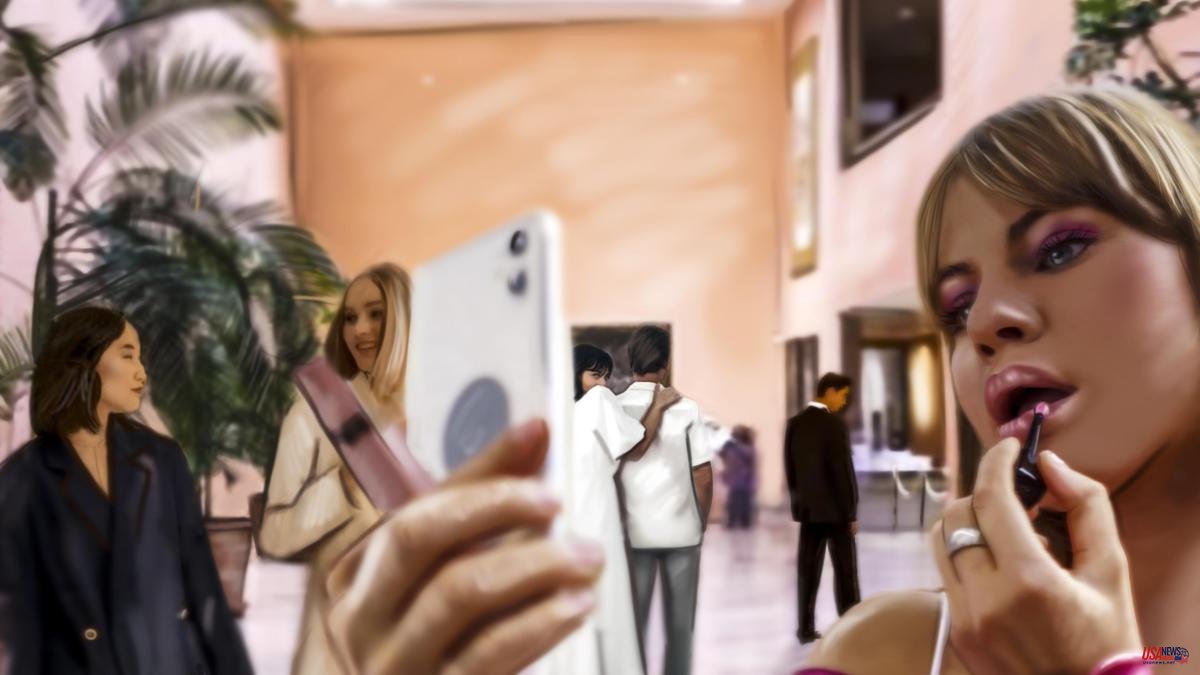The power of a lipstick. Never underestimate it. It is a small object that makes one's gaze face the mirror in order to apply it with care. In a certain way, it condenses the essence of beauty: lifting your spirits with a simple stroke, playing with colour, going beyond the rules or not, a conscious commitment to design and the sophistication of formulas that put treatment in the foreground. and care for your delicate skin. These are the common brushstrokes of those we have chosen as the best products of the year, loaded with research and science, new ideas and tastefully scented challenges.
Magazine's beauty awards return to the Thyssen-Bornemiza Museum to savor art as a representation of beauty with different sensibilities and accents. They receive their name and are inspired by 17 artists who dared to interpret reality with different eyes. The abstraction of Juan Gris, the woman who protects herself from the sun in an Impressionist garden by Renoir, the provocative expressionism of Kirchner, the colorful deconstructed Portuguese woman by Robert Delaunay, the voluptuousness of Venus by Rubens, the nude of a young peasant girl in front of Berthe Morisot… Portraits, landscapes and even a revolving house by Paul Klee that acts as a windmill to connect gestures and trends through time.
The cosmetics industry, like art, is anything but banal. Both are experts in interpreting the breath of society and intuiting and projecting what is to come. Diversity, inclusion and sustainability are today essential arguments that are applied to what is beautiful and open the doors to claim the difference. "Beauty begins with the decision to be yourself," said an inspired Coco Chanel. With prisms and edges, white, black, gray and colored illusions. The authentic claims its place in times of serial filters and is trading on the rise; the original –who are you– outsells the copy of the latest TikTok video. “The truth is in the face more than anywhere. I think that we women know that the face has a deep meaning”, wrote Zadie Smith in On Beauty.
The products recognized in these awards intimately help to express who we are with the legitimate ambition of showing the best cards. With more perseverance than magic solutions and with moments of happiness, like that perfume that delights our nose and sight or takes us on a walk through future memories. Admire the Thyssen paintings, feed the eyes and the soul, reflect with them with the liquid curiosity of honey falling from the spoon. Without putting them in a frame.
Mata Mua (Once Upon a Time), by Paul Gauguin (1892). Gauguin set the ideal of an imagined Tahiti between the naive, the ancestral and the postcard. Women who play the flute and dance before Hina, the goddess of the Moon, pink and purple mountains... Neither the scene nor the landscape are real, but rather a composition of elements that appear in other works by the artist.
Portrait of a Woman with a Cigarette (Kiki de Montparnasse), by Keesvan Dongen (circa1922-1924). A century later, Kiki de Montparnasse is still resoundingly modern. She holds the cigarette almost listlessly. She exudes self-confidence and has what is now called attitude. The great muse of Montparnasse – of Modigliani, of Chagall, of Man Ray… – was a talented woman and she surrounded herself with him.
In the hat shop, by Edgar Degas (1882). The painter used to accompany his friends, such as Mme Straus or the painter Mary Cassatt, through the new fashion stores in the capital. Here, he stands behind the counter of a hat shop to capture the right moment of the inevitable question we ask in front of the mirror: “How does it look on me?
Street with a Red Hooker, by Ernst Ludwig Kirchner (1914-1925). The woman dressed in red is planted in a corner of a decadent Berlin where the Great War is already intuited. She seeks the attention of men who seem to be in a hurry and moving at the urban pace. Expressionism. Street scenes that the same painter retouched in 1925 with broader and flatter brushstrokes.
Revolving House, 1921, 183, by Paul Klee(1921). “Art does not reproduce the visible, but rather makes something visible”, said the artist in his essay Creative Confession. In the consciously naive work, the architecture is dynamic, Klee rejects the traditional perspective and suppresses the unique point of view. Like the most innovative cosmetic formulas.
The House Among the Roses, by Claude Monet (1925). If a simple cataract operation changes the vision of any mortal, imagine what it does to the color perception of an impressionist painter. After undergoing surgery, he discovered an infinite number of nuances that he translated into a broader palette and intense work tinged with joy.
Woman with a Parasol in a Garden, by Pierre-Auguste Renoir (1875). The woman goes out into the large garden of the studio that surrounds the painter's studio in Montmartre with an umbrella to protect herself from the sun, the best gesture for skin care then and now. Her color brushes her black dress and a crouching man seems ready to give her a flower.
Seated Man, by Paul Cézanne (1905–1906). Vallier, Cézanne's gardener, who often modeled for him, is the center of this Portrait of a Peasant, painted in Aix-en-Provence. In his simple Provencal blue attire, he poses serene and dignified, with his cane and legs crossed. His face is barely visible.
Venus and Cupid, by Peter Paul Rubens (circa1606-1611). Rubens and his generously shaped women would today claim his space in an ideal of non-unique beauty where we all fit. In the work, very inspired by a work by Titian in which the goddess even wore the ring on her little finger, Cupid exchanges arrows for a mirror so that Venus can look at herself.
Santa Casilda, by Zurbarán (circa1630–1635). Dressed in a sumptuous dress and jewelry that denote great wealth, Santa Casilda, daughter of an Arab king who converted to Christianity, looks at the painter with a very feminine gesture. The artist's skill translates the quality of the cloth and the gesture of the folds when she picks up the skirt as if she were ascending to heaven.
Seated Woman, by Juan Gris (1917). "Picasso came back the day before yesterday and came to see me (...) I showed him my recent material and he seems to like it a lot," the artist wrote on May 5, 1917. His companion Josette Gris was there, always a lover of fashion, photographed from from the previous drawings, stylized and ready to go.
Portuguesa (the great Portuguese), by Robert Delaunay (1916). During World War I, Robert and Sonia Delauney spent a few years between Spain and Portugal. In Vila do Conde, near Porto, this joyous work was painted, inspired by the contrast of bright colors between the women's clothing and the cool tones of watermelons, pumpkins and legumes in the sun.
Loneliness. Souvenir de Vigen, Limousin, by Jean-Baptiste-Camille Corot (1866). The Empress Eugenia de Montijo was its first buyer. Perhaps she fell in love with that contemplative and melancholic woman who, sitting in front of the viewer, populates a landscape made of scraps of memories. Or that light that sneaks through the clouds to illuminate the water.
Les Vessenots in Auvers, by Vincent van Gogh (1890). The artist who captured lilies, sunflowers and flower bouquets so well spent his last days in Auvers-sur-Oise, near Paris. He painted outdoors, with thick and nervous brushstrokes and his very personal vision of beauty. Tranquility, always relative to him, is dressed in green, yellow and blue.
Reclining Nude Shepherdess, by Berthe Morisot (1891). This is the most ambitious nude of the painter. She admired those by Renoir and Degas, but here she makes the young woman pose before her eyes with a different, more personal pose. Her model keeps her headscarf (in other versions of her there was a goat next to her), the only thing that gives her away as a shepherdess.
Portrait of a Woman with a Cigarette (Kiki de Montparnasse), by Keesvan Dongen (circa1922-1924). A great portrait painter, Modigliani "takes possession of the characters around him", described the art historian Werner Schmalenbach. In this, the look goes to blue eyes whose expression is difficult to guess. Her face, in which many guess Kiki de Montparnasse, is almost a sketch.
The Brème Stream, by Gustave Courbet (1866). Courbet shared the famous phrase of Émile Zola: “The work of art is a fragment of creation seen through a temperament”. He was fascinated by hidden places, like this spot in a forest where a small stream flows between the rocks, in the middle of lush vegetation and you can breathe calm.













